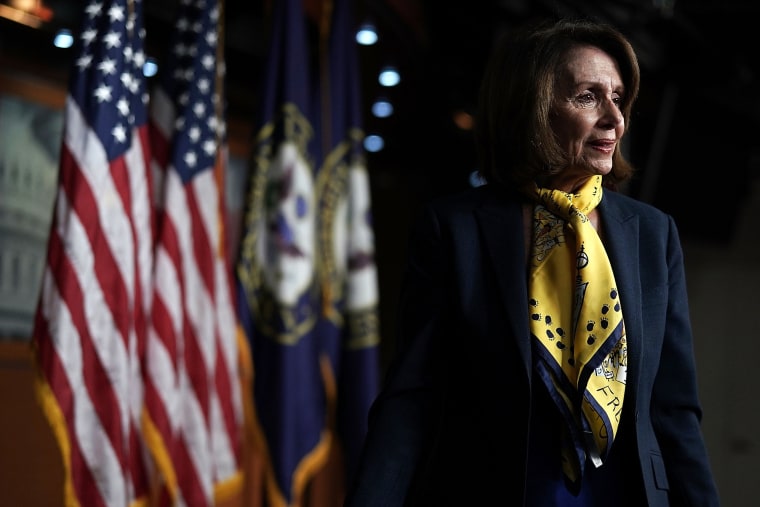Connor Lamb was just the beginning. In the wake of Lamb’s upset victory in the Pennsylvania special election earlier in March, a slew of House Democratic challengers are refusing to say that they will vote for Rep. Nancy Pelosi for House Speaker if they are elected to Congress. NBC’s Alex Seitz-Wald and Jon Allen found more than a dozen candidates who won’t back her — and even more who are ducking the question. That’s a big problem for Washington Democrats’ hopes of winning the House majority in the 2018 midterms.
President Donald Trump is unpopular. Democratic enthusiasm is surging. Republican Members of Congress are retiring in droves. But the so-called midterm “blue wave” is far from a sure bet.
In her own self-assessment, Pelosi noted, “I am a master legislator, I am a shrewd politician and I have a following in the country that, apart from a presidential candidate, nobody else can claim.” She’s certainly confident, but she’s also unpopular. And if she tries to cling to the leadership through November, she could very well ruin her party’s growing momentum.
President Donald Trump is unpopular. Republican Members of Congress are retiring in droves. But the so-called midterm “blue wave” is far from a sure bet.
The majority in the House of Representatives has changed three times in the past quarter century: 1994, 2006 and 2010. In each of those years, the opposition party won back the majority not just by offering a check on an unpopular president, but by offering a new and different governing agenda, rooted in the party principles.
In 1994, Newt Gingrich’s “Contract with America” helped blaze the trail for the first Republican House majority in 40 years. In 2006, against the backdrop of GOP ethics scandals and the unpopular war in Iraq, Pelosi’s Democrats retook that majority touting their “6 for ‘06” agenda. And yet, only four years later, in the wake of President Barack Obama’s stimulus package and Affordable Care Act, as well as the rise of the Tea Party, John Boehner united House Republican candidates behind the “Pledge to America” and won a huge comeback victory.
The point is that, historically speaking, being the “party of no” has not been enough to win the House majority — you need a positive platform. In this context, the growing lack of support for Pelosi is problematic for two reasons: without a strong leader like Gingrich, Pelosi (in ‘06) or Boehner, it is impossible to forge that agenda. Worse for Democrats, the anti-Pelosi forces are a symbol of the deeper divides among Democratic voters.
Historically speaking, being the “party of no” has not been enough to win the House majority — you need a positive platform.
The “Better Deal” agenda briefly touted by Senate Democratic Leader Chuck Schumer and Pelosi last year is a long-forgotten punchline. And while broadly united by their white-hot hatred of Trump, the Democrats are divided on nearly everything else.
On health policy, single-payer advocates war with defenders of Obama’s Affordable Care Act. The wing led by Massachusetts Senator Elizabeth Warren sees common-sense improvements in financial services regulation — backed by centrist Democrats — as an unconscionable giveaway to Wall Street. Some Democrats want a rollback of the recent tax reform law to fund higher government spending, while others want new, steep taxes on the rich to pay for far more generous and far-reaching new federal benefits.
And those are just the policy debates — which are far more genteel and mannerly than disagreements over race, class, gender, age and political tactics.
The Democratic challengers shunning Pelosi are not the cause of Democrats’ current “Hunger Games”-style internal conflicts — but they are a symptom. And if they can’t heal those divisions, when it comes to winning the House this year, the odds may actually not be in their favor.
A clean slate, and the promise of a leadership contest following the election would spur a healthy competition among potential new House Democratic leaders.
The best outcome for House Democrats would probably be a pledge from Pelosi that she will serve as Democratic leader in the House through Election Day, but will not take up the speaker’s gavel again if they win the majority. And, frankly, while neither of the other senior House Democratic leaders — Reps. Steny Hoyer and Jim Clyburn — are as polarizing as Pelosi, neither offers much hope for change. They, too, should pledge not to run for Speaker, and turn the reins over to the next generation of Democratic stars.
Pelosi loyalists would argue that the result of her stepping down would be a chaotic election-year leadership contest among House Democrats that would hurt their chances in the midterm election regardless. I disagree. A clean slate, and the promise of a leadership contest set to occur following the election would spur a healthy competition among potential new House Democratic leaders, and actually make victory more likely in November.

